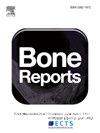Bone mineral density and microarchitecture improvement in a young patient with Hajdu-Cheney syndrome and autosomal dominant polycystic kidney disease treated with alendronate
IF 2.6
Q3 ENDOCRINOLOGY & METABOLISM
引用次数: 0
Abstract
Introduction
Osteoporosis, typically seen in postmenopausal women, can also affect younger individuals, a condition known as Early-Onset Osteoporosis (EOOP). EOOP may be secondary to various conditions or arise from rare genetic disorders such as Hajdu-Cheney Syndrome (HCS), characterized by systemic bone involvement and fragility fractures.
Case Report
A 14-year-old male presented with a distal left femur fragility fracture. His medical history included spina bifida and bilateral tarsal coalition, with no family history of osteoporosis, and polycystic kidneys associated with a positive family history of autosomal dominant polycystic kidney disease (ADPKD). Laboratory tests were unremarkable, but dual X-ray absorptiometry (DXA) revealed low bone mineral density (BMD), and high resolution peripheral quantitative computed tomography (HR-pQCT) showed decreased volumetric bone density (vBMD), particularly in the cortical bone. At age 17, his kidneys were cystic and mildly enlarged. Whole exome sequencing revealed a pathogenic variant in NOTCH2, confirming the diagnosis of HCS, and a very likely causative variant in PKD1, supporting the diagnosis of ADPKD.
The treatment regimen included weekly alendronate, impact exercise, a calcium-rich diet, and vitamin D supplementation. After 3 years, follow-up DXA and HR-pQCT demonstrated significant improvements in BMD and vBMD, mainly in the cortical bone.
Discussion
This case highlights the effectiveness of alendronate in managing osteoporosis in a patient with HCS and ADPKD, despite the current lack of strong supportive evidence. Long-term monitoring revealed substantial improvements in bone density and microarchitecture, underscoring the importance of early diagnosis and intervention for genetic causes of osteoporosis to prevent fracture-related morbidity.
阿仑膦酸钠治疗Hajdu-Cheney综合征合并常染色体显性多囊肾病年轻患者的骨密度和微结构改善
骨质疏松症,通常见于绝经后妇女,也可以影响年轻人,这种情况被称为早发性骨质疏松症(EOOP)。EOOP可能继发于各种疾病,或由Hajdu-Cheney综合征(HCS)等罕见遗传疾病引起,其特征是全身骨骼受累和脆性骨折。病例报告:一名14岁男性表现为左股骨远端脆性骨折。病史包括脊柱裂和双侧跗骨联合,无骨质疏松家族史,多囊肾伴常染色体显性多囊肾病(ADPKD)家族史阳性。实验室检查无明显异常,但双x线吸收仪(DXA)显示低骨密度(BMD),高分辨率外周定量计算机断层扫描(HR-pQCT)显示体积骨密度(vBMD)下降,尤其是皮质骨。17岁时,他的肾脏呈囊状并轻度增大。全外显子组测序显示NOTCH2的致病变异,证实了HCS的诊断,PKD1的致病变异非常可能,支持ADPKD的诊断。治疗方案包括每周阿仑膦酸钠、冲击性运动、富含钙的饮食和补充维生素D。3年后,随访DXA和HR-pQCT显示BMD和vBMD显著改善,主要在皮质骨。本病例强调了阿仑膦酸钠治疗HCS和ADPKD患者骨质疏松症的有效性,尽管目前缺乏强有力的支持证据。长期监测显示骨密度和微结构的显著改善,强调了早期诊断和干预骨质疏松症遗传原因以预防骨折相关发病率的重要性。
本文章由计算机程序翻译,如有差异,请以英文原文为准。
求助全文
约1分钟内获得全文
求助全文
来源期刊

Bone Reports
Medicine-Orthopedics and Sports Medicine
CiteScore
4.30
自引率
4.00%
发文量
444
审稿时长
57 days
期刊介绍:
Bone Reports is an interdisciplinary forum for the rapid publication of Original Research Articles and Case Reports across basic, translational and clinical aspects of bone and mineral metabolism. The journal publishes papers that are scientifically sound, with the peer review process focused principally on verifying sound methodologies, and correct data analysis and interpretation. We welcome studies either replicating or failing to replicate a previous study, and null findings. We fulfil a critical and current need to enhance research by publishing reproducibility studies and null findings.
 求助内容:
求助内容: 应助结果提醒方式:
应助结果提醒方式:


